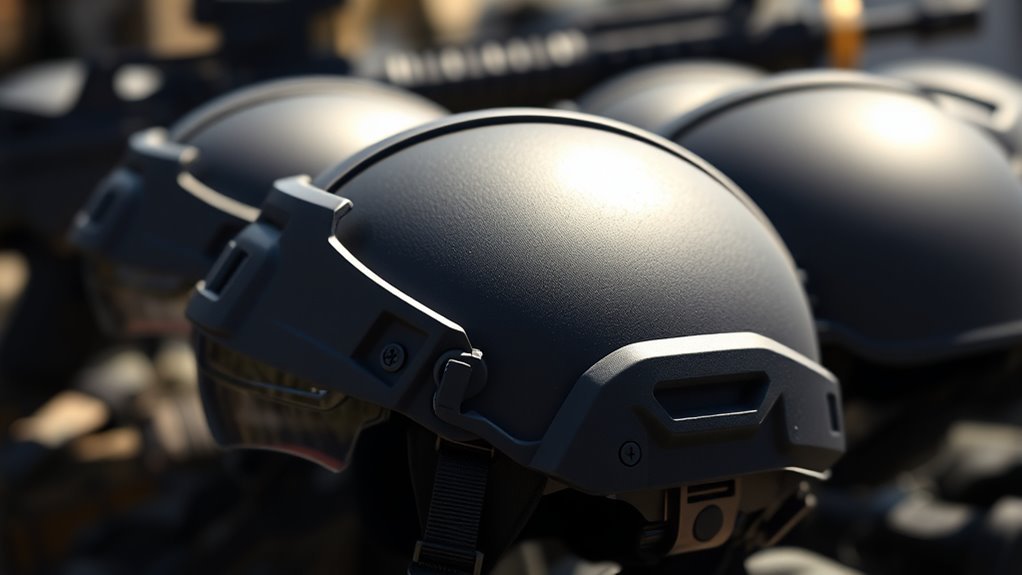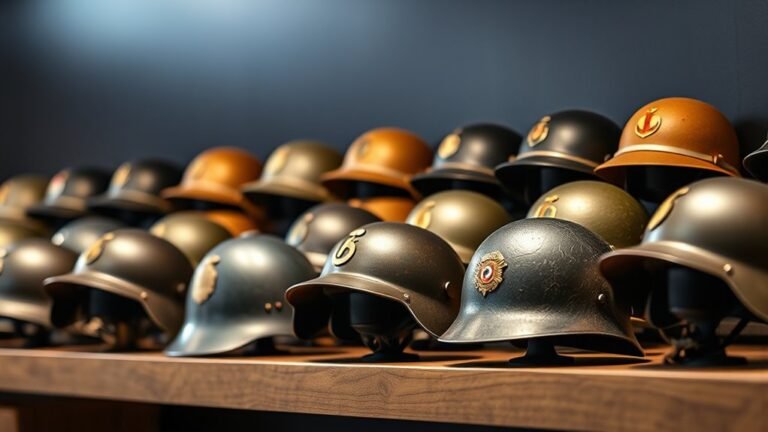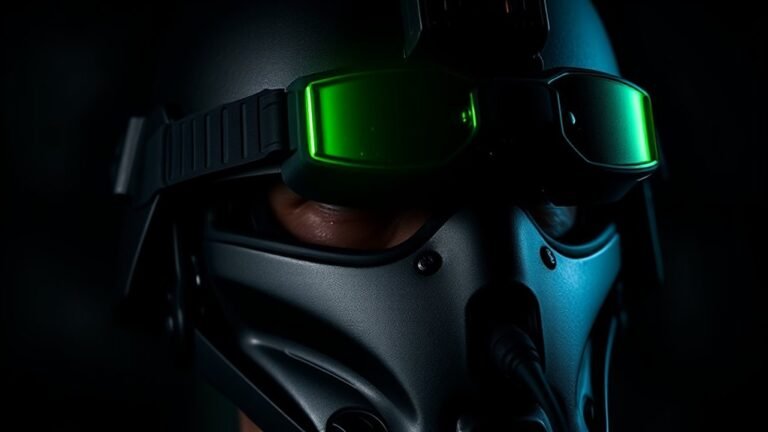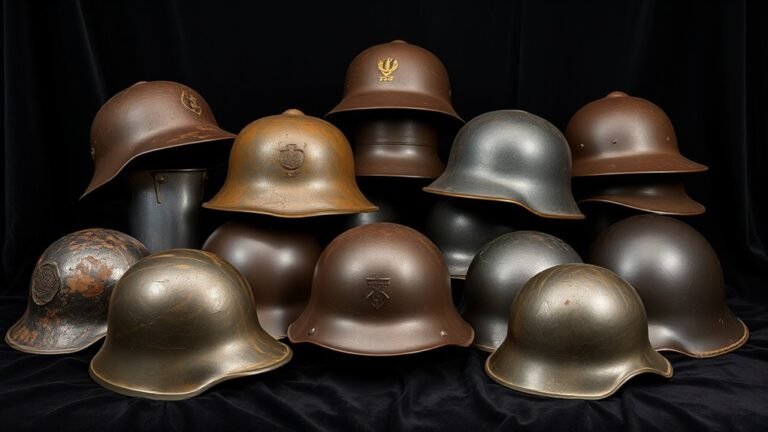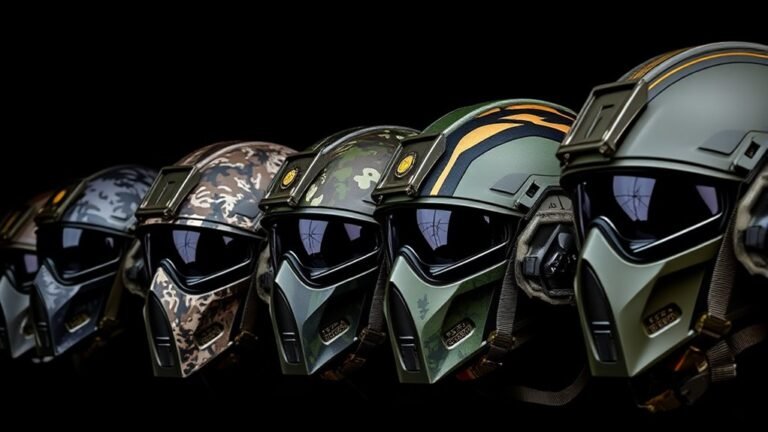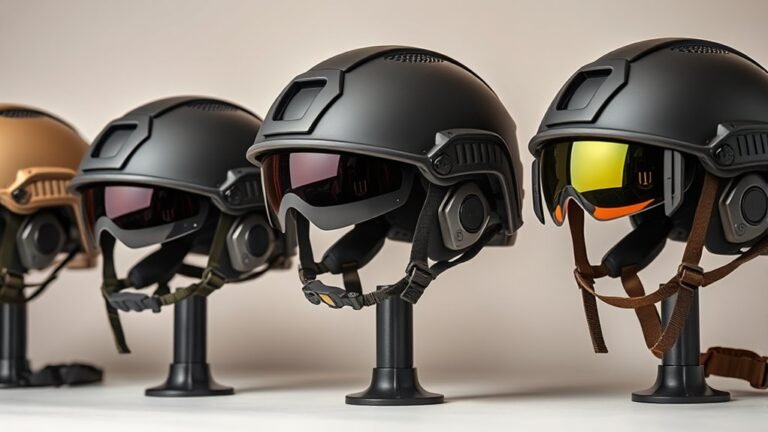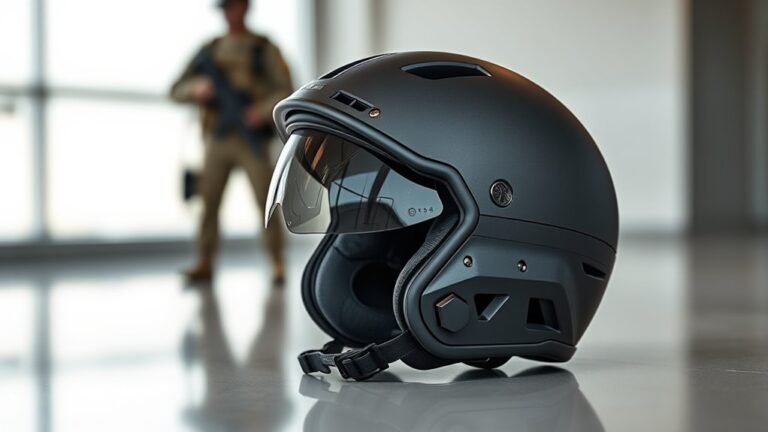Best Ballistic Helmets for Tactical Use
When choosing the best ballistic helmets for tactical use, prioritize helmets that meet NIJ Level IIIA ratings for handgun protection. Look for advanced materials like Kevlar or Twaron that balance weight and durability. Key features include comfort-focused designs with adjustable fit and compatibility for accessories like communication systems. Helmets such as the ACH and Team Wendy EXFIL excel in military and law enforcement scenarios. Discovering additional specifications and options will enhance your operational readiness even further.
Understanding Ballistic Helmet Ratings
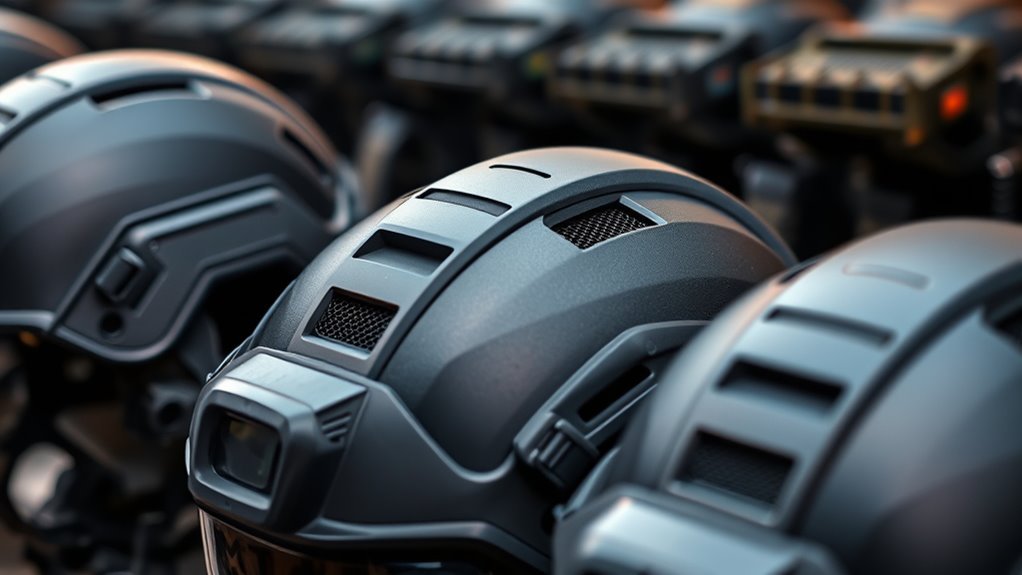
When evaluating ballistic helmets, it’s essential to understand the rating systems that determine their protective capabilities. The ballistic standards overview typically includes classifications set by organizations like the National Institute of Justice (NIJ) and the U.S. Army. These standards gauge a helmet’s ability to withstand specific threats, from handgun rounds to high-velocity rifle fire. Helmet rating explanations clarify the levels of protection; for instance, NIJ Level IIIA helmets offer excellent protection against most handgun threats but may not withstand rifle fire. Familiarizing yourself with these ratings guarantees you make informed choices tailored to your operational needs. Understanding these aspects empowers you to prioritize safety without sacrificing freedom in tactical situations.
Key Features to Look for in a Ballistic Helmet
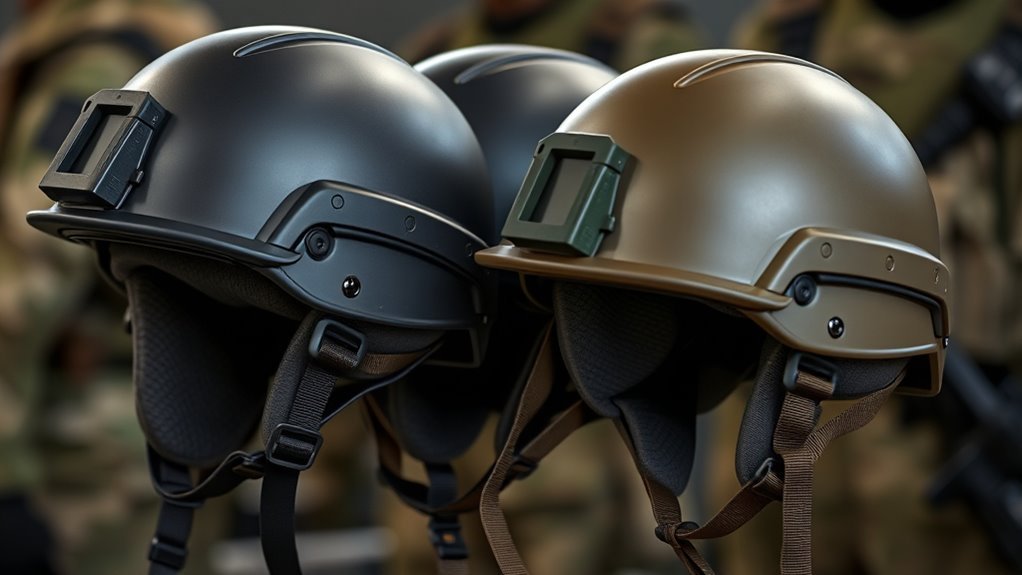
Understanding helmet ratings is just the first step in selecting the right ballistic helmet for tactical use. You’ll want to focus on ballistic helmet materials, as they directly impact protection and durability. Look for advanced composites like Kevlar or Twaron, which offer excellent ballistic resistance while remaining lightweight. Helmet weight considerations are essential too—heavier helmets can lead to fatigue during extended wear, affecting your performance. Aim for a balance between protection and weight; lighter models often provide adequate defense for tactical situations. Additionally, consider the helmet’s fit and compatibility with accessories like night vision devices. Prioritize features that enhance both safety and comfort, ensuring you’re ready to operate effectively in demanding environments.
Top Ballistic Helmets for Military Use
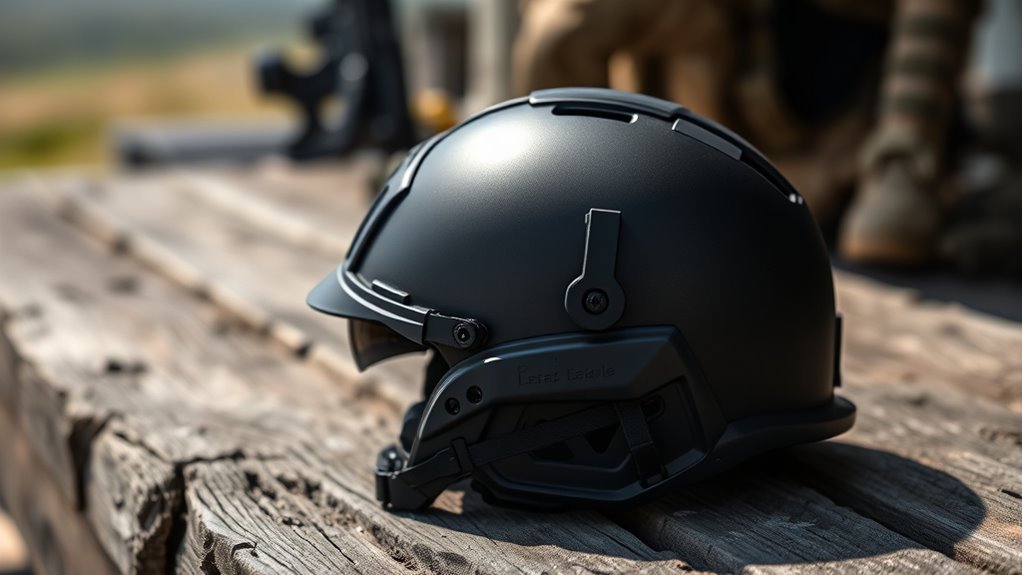
While selecting the top ballistic helmets for military use, it’s crucial to contemplate models that combine advanced protection with operational versatility. Look for helmets featuring ballistic helmet innovations, such as integrated communication systems and modular mounting options. The ACH (Advanced Combat Helmet) remains a benchmark, offering a balance of weight and protection. In tactical helmet comparisons, the MICH (Modular Integrated Communications Helmet) stands out due to its adaptability for various mission profiles. The Team Wendy EXFIL provides exceptional comfort and impact resistance, making it a favorite among many units. Consider your specific needs, like weight, coverage, and additional features, to guarantee your helmet not only protects but also enhances your operational effectiveness in the field.
Best Ballistic Helmets for Law Enforcement
Ballistic helmets designed for law enforcement require a different focus compared to military models, emphasizing rapid response and urban operational needs. In law enforcement applications, these helmets must meet stringent helmet safety standards while providing comfort and mobility. Here’s a brief overview of key features to take into account:
| Feature | Importance |
|---|---|
| Impact Resistance | Protects against blunt trauma |
| Weight | Guarantees agility during operations |
| Communication Systems | Enhances team coordination |
| Visor Integration | Offers face protection without hindrance |
| Custom Fit Options | Improves comfort for extended wear |
Selecting the right ballistic helmet is essential for your safety and effectiveness in the field. Remember, your protection is paramount in guaranteeing you can serve and protect without compromise.
Recommended Ballistic Helmets for Civilian Use
When selecting a ballistic helmet for civilian use, it’s essential to focus on top choices that balance protection and comfort. You’ll want to take into account key features such as weight, material, and ballistic rating to guarantee peak performance. Understanding these factors will help you make an informed decision tailored to your specific needs.
Top Civilian Choices
Choosing the right ballistic helmet for civilian use can greatly enhance your safety and preparedness. When considering options for civilian applications, you’ll want to focus on helmets that provide both protection and the ability for helmet customization. Here are some top choices:
- Team Wendy EXFIL Ballistic Helmet: Offers modular accessories for personalization.
- MTEK Flux Ballistic Helmet: Highly adjustable fit and lightweight design.
- Ops-Core FAST Ballistic Helmet: Known for its high-level protection and comfort.
- Tactical Assault Gear (TAG) Ballistic Helmet: Budget-friendly option with essential features.
Each of these helmets meets various needs, guaranteeing you can find the right fit for your lifestyle and requirements. Prioritize quality, comfort, and adaptability to guarantee you’re ready for any situation.
Key Features to Consider
While there are numerous options available, understanding the key features of ballistic helmets is essential for guaranteeing ideal protection and functionality. First, consider the ballistic materials; Kevlar and Twaron are commonly used for their lightweight yet robust properties, providing effective resistance against various threats. Next, evaluate the helmet styles available—such as high-cut, mid-cut, and full-cut—each offering different levels of coverage and compatibility with accessories like communication gear. Additionally, look for adjustable suspension systems, which enhance comfort and stability during use. Finally, verify the helmet meets relevant ballistic standards to guarantee its protective capabilities. By focusing on these features, you can choose a ballistic helmet that not only safeguards but also supports your freedom in tactical scenarios.
Comparing Weight and Comfort in Ballistic Helmets
When selecting a ballistic helmet, you’ll need to take into account weight distribution as it directly affects your mobility and endurance. The right padding and fit can greatly enhance comfort during extended wear, while the materials used in construction play an essential role in overall usability. By understanding these factors, you can make an informed decision that balances protection with comfort.
Weight Distribution Importance
Understanding the significance of weight distribution in ballistic helmets is essential for optimizing both comfort and performance in tactical scenarios. Proper weight distribution directly influences your tactical efficiency, enabling you to maintain focus and mobility during critical operations.
Key factors to evaluate include:
- Center of Gravity: A balanced helmet reduces neck strain and enhances stability.
- Material Choice: Lighter materials can improve comfort without compromising protection.
- Adjustable Components: Customizable straps and harnesses allow for personalized fit, improving balance.
- Design Features: Helmets designed with weight distribution in mind can facilitate better movement and reduce fatigue.
Padding and Fit
Choosing the right padding and fit for a ballistic helmet is essential, as it directly impacts both weight and comfort during tactical operations. Proper padding adjustments can greatly enhance your experience, reducing fatigue and allowing you to maintain focus. Helmets with adjustable padding systems enable fit customization, ensuring a snug yet comfortable fit that accommodates various head shapes and sizes. This personalized fit not only improves stability during movement but also minimizes the risk of injury. When selecting a helmet, prioritize options with high-quality, moisture-wicking materials that provide cushioning without adding excessive weight. Remember, a well-fitted helmet enhances your operational effectiveness, allowing you to perform with confidence and freedom in high-stakes environments.
Materials Impact Comfort
While the choice of materials in ballistic helmets markedly affects both weight and comfort, it’s crucial to strike a balance that meets operational needs. Lightweight materials can enhance maneuverability but may compromise material durability. Conversely, heavier options might offer increased protection but can lead to discomfort during prolonged wear. Here are some critical comfort factors to take into account:
- Weight distribution: A well-balanced helmet reduces neck strain.
- Breathability: Ventilated materials help regulate temperature during intense activities.
- Padding quality: High-density foam improves shock absorption and comfort.
- Adjustment features: Customizable fit enhances stability and reduces pressure points.
Ultimately, selecting the right combination of materials guarantees you maintain agility while preserving safety and comfort on the field.
Accessories and Add-Ons for Ballistic Helmets
When outfitting your ballistic helmet for tactical scenarios, a variety of accessories and add-ons can greatly enhance functionality and protection. You’ve got numerous accessory options that can transform your standard helmet into a multi-purpose tool. Consider attaching night vision mounts, which allow for enhanced visibility in low-light conditions, or communication headsets for seamless coordination during operations. Helmet upgrades like ballistic visors can also provide additional face protection without sacrificing mobility. Don’t overlook padding systems that improve comfort and fit, making certain your helmet remains secure during use. Ultimately, selecting the right accessories can considerably boost your operational effectiveness, allowing you to maintain tactical advantage and freedom in the field. Prioritize your gear to make sure it meets your specific mission requirements.
Maintenance and Care for Your Ballistic Helmet
To guarantee your ballistic helmet remains effective and durable, regular maintenance and care are essential. Proper upkeep involves specific cleaning techniques and storage recommendations to extend its lifespan. Here are key practices to follow:
Regular maintenance and care are crucial for ensuring your ballistic helmet’s effectiveness and durability.
- Clean using mild soap and water: Avoid harsh chemicals that could damage the materials.
- Inspect for damage regularly: Check for cracks, dents, or any signs of wear that could compromise protection.
- Store in a cool, dry place: Extreme temperatures can degrade the helmet’s integrity, so maintain stable conditions.
- Avoid stacking or heavy loads: This prevents deformation and preserves the shape of your helmet.
Budget-Friendly Options for Tactical Helmets
Maintaining your ballistic helmet is essential for its longevity and performance, but it’s also important to take into account your budget when selecting a tactical helmet. Fortunately, there are several affordable options that don’t compromise on quality. Brands like Team Wendy and Ops-Core offer budget-friendly models that provide reliable protection without breaking the bank. These tactical helmets often feature lightweight designs and compatibility with essential tactical gear, ensuring you remain agile in the field. When choosing, consider factors like ballistic rating and comfort, as these elements are vital for effective use. Investing in a budget-friendly helmet means you can prioritize safety while still having the resources to enhance your overall tactical setup. Choose wisely and equip yourself effectively.
Frequently Asked Questions
Can Ballistic Helmets Protect Against Blunt Force Trauma?
Yes, ballistic helmets can provide some level of blunt force protection, but it’s essential to understand their limitations. Constructed from advanced helmet materials like Kevlar and carbon fiber, these helmets excel in stopping projectiles. However, blunt force impacts can still transmit energy to your head. Think of it as having a shield; it offers defense, yet the force can still leave a mark. Always consider additional protective gear for thorough safety in high-risk situations.
Are There Specific Sizing Guidelines for Ballistic Helmets?
Yes, there are specific sizing guidelines for ballistic helmets. You’ll want to refer to the sizing standards provided by the manufacturer, which typically include measurements for head circumference. To find your size, measure around the widest part of your head, just above the ears. Make sure you select a helmet that fits snugly without being overly tight, as proper helmet measurements are essential for both comfort and effective protection during tactical operations.
How Do I Properly Fit a Ballistic Helmet?
To properly fit a ballistic helmet, start by measuring your head circumference. Use the adjustment techniques provided by the manufacturer, such as the dial system or padding adjustments. Make certain the helmet sits level on your head, covering your forehead without obstructing vision. Check for a snug fit, allowing only minimal movement. Finally, secure the chin strap for stability. A well-fitted helmet enhances protection and comfort, essential for your operational effectiveness.
What Is the Lifespan of a Ballistic Helmet?
Ah, the noble ballistic helmet! You might think it’s immortal, but it’s not a superhero. Typically, its lifespan hovers around 5 to 10 years, depending on factors like usage, environmental conditions, and maintenance. To extend its life, regularly inspect for cracks and wear, and store it in a cool, dry place. Remember, a well-cared-for helmet isn’t just a fashion statement; it’s your best ally in preserving freedom and safety.
Can I Customize My Ballistic Helmet’s Appearance?
Yes, you can customize your ballistic helmet’s appearance. Many manufacturers offer a range of helmet accessories, including modular attachments for lights, visors, and communication devices. You’ll also find various color options, allowing you to match your helmet with your tactical gear or personal preference. When customizing, make certain that any accessories maintain the helmet’s ballistic integrity and don’t compromise its protective capabilities while enhancing both functionality and aesthetics.
